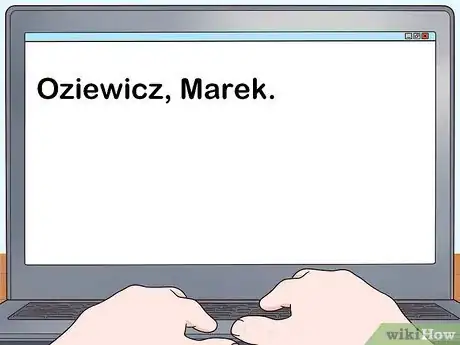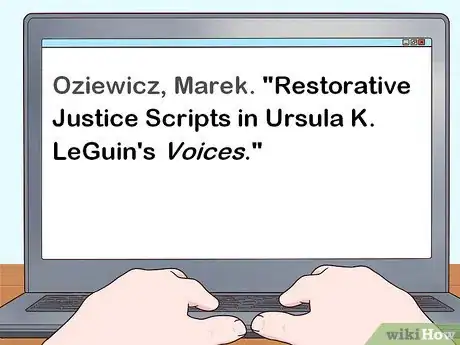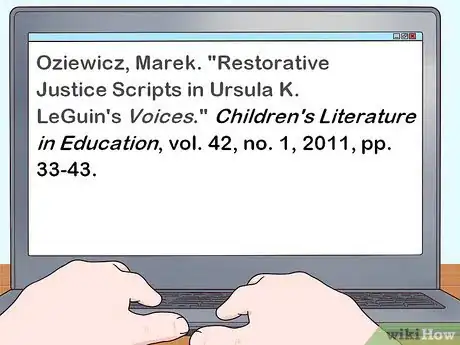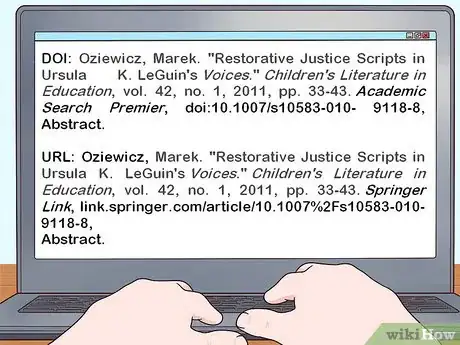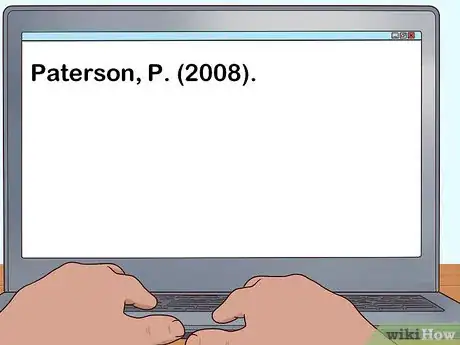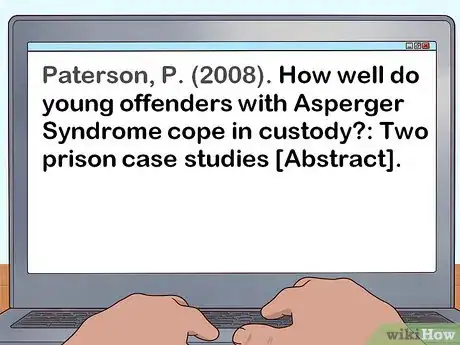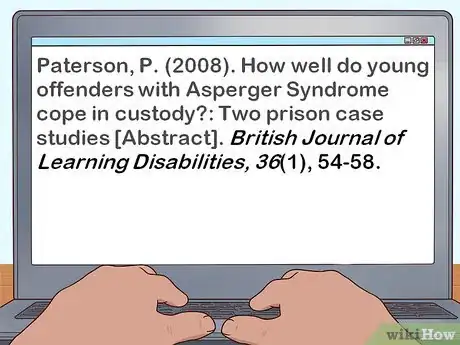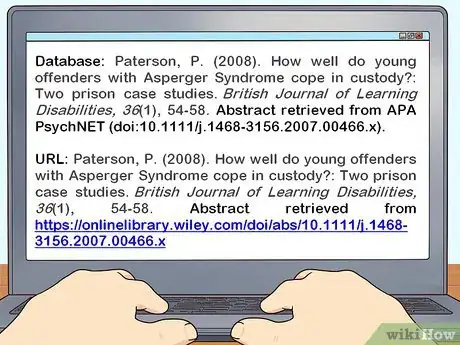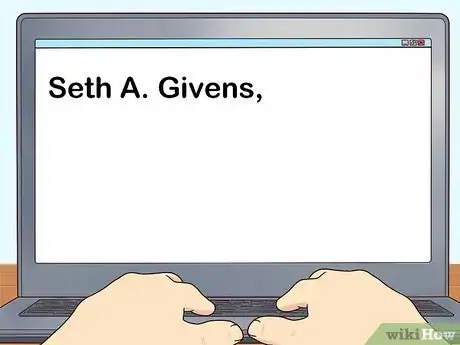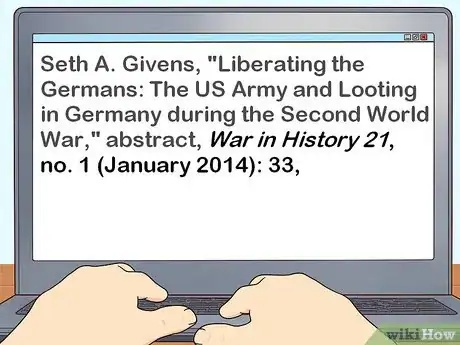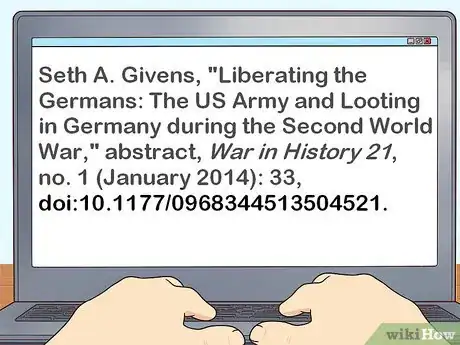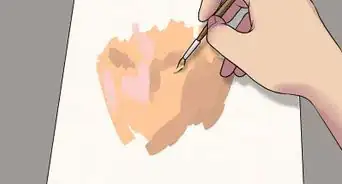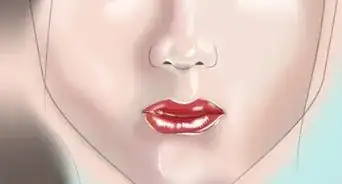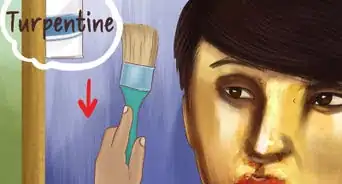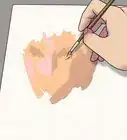This article was co-authored by wikiHow staff writer, Jennifer Mueller, JD. Jennifer Mueller is a wikiHow Content Creator. She specializes in reviewing, fact-checking, and evaluating wikiHow's content to ensure thoroughness and accuracy. Jennifer holds a JD from Indiana University Maurer School of Law in 2006.
This article has been viewed 42,695 times.
Learn more...
Scholarly articles have abstracts available online that provide a summary of the article and conclusions reached in it. Usually, you should try to get the full article to read and use as a source. However, if you decide to use the abstract itself as a source, you need a citation for it. The format of your citation differs depending on whether you're using the Modern Language Association (MLA), American Psychological Association (APA), or Chicago citation style.
Steps
MLA
-
1Start your Works Cited entry with the author's name. Type the last name of the author of the article, followed by a comma. Then type the author's first name. Include the author's middle name or initial, if provided. Place a period after the author's name.[1]
- Example: Oziewicz, Marek.
-
2Provide the title of the article. After the author's name, copy the full title of the article in quotation marks. Use title case, capitalizing all nouns, pronouns, verbs, and adverbs. Place a period at the end of the title, inside the closing quotation marks.[2]
- Example: Oziewicz, Marek. "Restorative Justice Scripts in Ursula K. LeGuin's Voices."
Advertisement -
3Include information about the journal where the article is published. After the article title, type the title of the journal in italics. Place a comma after the journal title, then include the volume number, issue number, and year of publication. Separate these elements with commas. Place a comma after the year of publication, then type the abbreviation "pp." followed by the page range where the article appears in the journal. Place a period after the final page number.[3]
- Example: Oziewicz, Marek. "Restorative Justice Scripts in Ursula K. LeGuin's Voices." Children's Literature in Education, vol. 42, no. 1, 2011, pp. 33-43.
-
4List the website or database where the abstract is located. Type the name of the website or database in italics, followed by a comma. Then copy the URL or Digital Object Identifier (DOI) for the abstract. Place a comma after the URL or DOI, then type the word "Abstract" to indicate that you are only citing the abstract, not the article as a whole. Place a period at the end.[4]
- DOI example: Oziewicz, Marek. "Restorative Justice Scripts in Ursula K. LeGuin's Voices." Children's Literature in Education, vol. 42, no. 1, 2011, pp. 33-43. Academic Search Premier, doi:10.1007/s10583-010- 9118-8, Abstract.
- URL example: Oziewicz, Marek. "Restorative Justice Scripts in Ursula K. LeGuin's Voices." Children's Literature in Education, vol. 42, no. 1, 2011, pp. 33-43. Springer Link, link.springer.com/article/10.1007%2Fs10583-010-9118-8, Abstract.
MLA Works Cited Format
Last Name, First Name. "Title of Article." Title of Journal, vol. x, no. x, Year, pp. xx-xx. Database or Website Name, DOI or URL, Abstract.
-
5Use the author's last name for in-text citations. An MLA in-text citation typically includes the author's last name and page number in a parenthetical. Since an online abstract doesn't have page numbers, only include the author's last name. Place your parenthetical at the end of any sentence where you paraphrase or quote the abstract, inside the closing punctuation.[5]
- Example: "Children's literature, particularly fantasy and speculative fiction, teaches young readers the values of inclusiveness and equality (Oziewicz)."
- If you incorporate the author's last name in the text of your paper, you don't need any parenthetical citation at all. For example: "Marek Oziewicz finds that works of fantasy teach young readers ideas of social justice that they can apply in the real world."
APA
-
1Start with the author's name and year of publication. In your reference list, type the last name of the author of the article. Place a comma after the author's last name, then type the author's first initial. Include their middle initial if it is available. After the author's name, type the year of publication in parentheses. Place a period after the closing parentheses.[6]
- Example: Paterson, P. (2008).
-
2List the title of the article and indicate you're citing the abstract. Type the title of the article in sentence case, capitalizing only the first word and any proper nouns. If the article has a subhead, type a colon at the end of the heading, followed by the subhead. Add the word "Abstract" in square brackets, followed by a period.[7]
- Example: Paterson, P. (2008). How well do young offenders with Asperger Syndrome cope in custody?: Two prison case studies [Abstract].
-
3Include information about the journal where the article appears. Type the name of the journal in italics, followed by a comma. Add the volume number for the journal, also in italics. Place the issue number in parentheses immediately after the volume number. Do not italicize the issue number. Place a comma after the closing parentheses, then type the page range where the article appears in the issue. Close your citation with a period.[8]
- Example: Paterson, P. (2008). How well do young offenders with Asperger Syndrome cope in custody?: Two prison case studies [Abstract]. British Journal of Learning Disabilities, 36(1), 54-58.
-
4Alter the format if the full text of the article is not available. Typically, the full text of the article will be available – even if you couldn't access it yourself, or didn't read it. If it isn't, use the format for an article retrieved from a database. Before the name of the database or website, type "Abstract retrieved from."[9]
- Database example: Paterson, P. (2008). How well do young offenders with Asperger Syndrome cope in custody?: Two prison case studies. British Journal of Learning Disabilities, 36(1), 54-58. Abstract retrieved from APA PsychNET (doi:10.1111/j.1468-3156.2007.00466.x).
- URL example: Paterson, P. (2008). How well do young offenders with Asperger Syndrome cope in custody?: Two prison case studies. British Journal of Learning Disabilities, 36(1), 54-58. Abstract retrieved from https://onlinelibrary.wiley.com/doi/abs/10.1111/j.1468-3156.2007.00466.x
APA Reference List Format
Full text available:
Last Name, First Initial. (Year). Title of article in sentence-case: Subtitle of article [Abstract]. Title of Journal, Volume(Issue#), xx-xx.Full text unavailable:
Last Name, First Initial. (Year). Title of article in sentence-case: Subtitle of article. Title of Journal, Volume(Issue#), xx-xx. Abstract retrieved from Database Name (doi).Last Name, First Initial. (Year). Title of article in sentence-case: Subtitle of article. Title of Journal, Volume(Issue#), xx-xx. Abstract retrieved from URL.
-
5Use the author's last name and year for in-text citations. When you paraphrase or quote the abstract in your paper, include a parenthetical at the end of the sentence with the author's last name and the year. Place the sentence's closing punctuation outside the closing parentheses.[10]
- Example: "Normal difficulties encountered by people with autistic spectrum disorders are compounded when they are sent to prison (Paterson, 2008)."
- If you include the author's name in the text of your paper, simply place the date of publication in parentheses immediately after their name. For example: "Paterson (2008) concluded limited resources were available for prisoners with autistic spectrum disorders."
Chicago
-
1Start your footnote with the first and last name of the author. In Chicago style, abstracts only need to be cited in the footnotes of your paper, not in the bibliography. Place a superscript number at the end of any sentence in which you quoted or paraphrased the abstract. The first element of your footnote is the author's name, in first name-last name format. Place a comma after the author's name.[11]
- Example: Seth A. Givens,
-
2Provide the title of the article and note you're citing the abstract. After the author's name, type the title of the article in quotation marks. Use title case, capitalizing all nouns, pronouns, verbs, and adverbs. Place a comma at the end of the title, inside the closing quotation marks. Then type the word "abstract," followed by a comma.[12]
- Example: Seth A. Givens, "Liberating the Germans: The US Army and Looting in Germany during the Second World War," abstract,
-
3Include information about the journal where the full article appears. Type the name of the journal and volume in italics, followed by a comma. Then type the issue number, followed by the date of publication in parentheses. Type a colon after the closing parentheses, then provide the page range where the article appears. Place a comma after the last page number.[13]
- Example: Seth A. Givens, "Liberating the Germans: The US Army and Looting in Germany during the Second World War," abstract, War in History 21, no. 1 (January 2014): 33,
-
4Close with a DOI or URL for the abstract. If you accessed an electronic version of the abstract, copy the DOI or URL for the article into your footnote. Chicago style prefers a DOI over a URL. Place a period at the end of the number.[14]
- Example: Seth A. Givens, "Liberating the Germans: The US Army and Looting in Germany during the Second World War," abstract, War in History 21, no. 1 (January 2014): 33, doi:10.1177/0968344513504521.
Chicago Footnote Format
First Name Last Name, "Title of Article: Subtitle of Article," abstract, Title of Journal Volume#, no. x (Month Year): Page#, doi/URL.
Warnings
- Avoid citing an abstract if the full text of the article is available. If you don't have access to the article, talk to your instructor or to a research librarian.⧼thumbs_response⧽
References
- ↑ https://www.landmark.edu/uploads/pages/doc/MLA-Citation-Guide-8th-ed.pdf
- ↑ https://www.landmark.edu/uploads/pages/doc/MLA-Citation-Guide-8th-ed.pdf
- ↑ https://www.landmark.edu/uploads/pages/doc/MLA-Citation-Guide-8th-ed.pdf
- ↑ https://www.landmark.edu/uploads/pages/doc/MLA-Citation-Guide-8th-ed.pdf
- ↑ https://owl.purdue.edu/owl/research_and_citation/mla_style/mla_formatting_and_style_guide/mla_in_text_citations_the_basics.html
- ↑ https://owl.purdue.edu/owl/research_and_citation/apa_style/apa_formatting_and_style_guide/reference_list_electronic_sources.html
- ↑ https://owl.purdue.edu/owl/research_and_citation/apa_style/apa_formatting_and_style_guide/reference_list_electronic_sources.html
- ↑ https://owl.purdue.edu/owl/research_and_citation/apa_style/apa_formatting_and_style_guide/reference_list_electronic_sources.html
- ↑ https://owl.purdue.edu/owl/research_and_citation/apa_style/apa_formatting_and_style_guide/reference_list_electronic_sources.html
- ↑ https://owl.purdue.edu/owl/research_and_citation/apa_style/apa_formatting_and_style_guide/reference_list_electronic_sources.html
- ↑ https://library.ship.edu/c.php?g=21703&p=127139
- ↑ https://library.ship.edu/c.php?g=21703&p=127139
- ↑ https://library.ship.edu/c.php?g=21703&p=127139
- ↑ https://library.ship.edu/c.php?g=21703&p=127139
